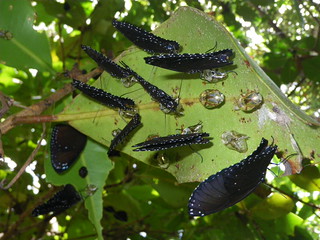 |
| Boiga irregularis |
The
Ecology of Bird Loss Project investigates the ecological importance of birds for
forests and the consequences of losing birds on ecosystem processes that
maintain biodiversity, support functioning ecosystems, and provide ecosystem
services to people.
Our
field research takes place on the Mariana Islands in the western Pacific Ocean.
The Brown Tree Snake (Boiga irregularis)
was introduced to the southernmost island in this chain, Guam, in the 1940s.
Since then, it has caused the functional extirpation of all native forest bird
species, resulting is the world’s only contemporary case of whole-ecosystem
bird loss in the world. With nearby islands that are otherwise similar, this
system provides a unique “natural experiment” to understand the importance of
birds for forests. Because Guam also represents a severe example of the global
phenomenon of vertebrate decline and extinction, it can offer insights into the
scope and severity of the impacts of this phenomenon that are occurring
globally. Our research focuses on the following areas:
 | |
| Mariana Fruit Dove |
Seed Dispersal: Roughly half of the world’s
plant species are dispersed to some extent by vertebrates, and up to 90% of
trees in the world’s most diverse ecosystems – tropical forests – rely on
animals for seed dispersal. In Guam, birds disperse approximately 70% of the
tree species, and the loss of seed dispersal could strongly reduce the regeneration
ability of Guam’s forest species.
Seed
dispersal can benefits plants in several ways: 1) by handling fruits and seeds,
birds can increase the probability and pace of germination, 2) by moving seeds
away from parent trees, birds help seeds escape the area of high predation,
disease, and competition near members of its same species, 3) by moving seeds
to specific microsites (e.g., treefall gaps), birds help seeds reach areas that
are favorable for germination and growth, and 4) by transporting seeds to new
areas (e.g., deforested areas or ), birds help tree species colonize new
habitats.
We have
found that the loss of seed dispersal can severely reduce recruitment of tree
species on Guam, with large negative impacts for plants that cannot escape areas of high mortality near members of their same species and for seeds that
are not removed from fruit pulp. Dispersal also strongly affects the
biodiversity of plants across the landscape, with the biodiversity hotspots
of regeneration within forests – treefall gaps – strongly reduced in the
absence of dispersal.
 |
| Papaya tree in gap |
Predation: Vertebrates take a top role in
food webs in ecosystems across the world. On Guam, seven insectivorous bird
species formed the top of the terrestrial food web, but are now absent. The
loss of top predators can reverberate across food webs, with negative cascading
impacts on lower trophic levels. In forests, the loss of insect predators could result in increased insect abundance and therefore increased herbivory on
plants, linking bird declines to negative impacts on plants. This is relevant
to agricultural systems if birds no longer are present to control agricultural
pests.
Our
research on trophic changes following bird decline has revealed large responses
of other important insect predators – spiders – following bird loss. We found
that spider abundances on Guam range from 2 to 40 times greater than spiders on
islands with birds. Ongoing projects explore the hypotheses that the increase
in spiders represents a form of ecological resilience, buffering the ecosystem
from insect abundance and herbivory increases that would otherwise result from
bird loss. Pollination: Two bird species likely
pollinated trees in the native forests of Guam: the Micronesian Honeyeater and
the Bridled White-eye, and the loss of these pollinators could reduce
regeneration of plant species that rely on birds for pollination. However,
there are very few tree species with flowers that clearly follow the bird pollination syndrome. We examined the potential for a lack of bird pollination to mediate plant population decline on Guam, but found that although birds visit the flowers of many species, experimentally excluding birds did not strongly affect the number of seeds they were able to produce. Therefore the loss of birds’ role as pollinators appears to be a weaker driver of ecosystem change following bird loss on Guam.
Pollination: Two bird species likely
pollinated trees in the native forests of Guam: the Micronesian Honeyeater and
the Bridled White-eye, and the loss of these pollinators could reduce
regeneration of plant species that rely on birds for pollination. However,
there are very few tree species with flowers that clearly follow the bird pollination syndrome. We examined the potential for a lack of bird pollination to mediate plant population decline on Guam, but found that although birds visit the flowers of many species, experimentally excluding birds did not strongly affect the number of seeds they were able to produce. Therefore the loss of birds’ role as pollinators appears to be a weaker driver of ecosystem change following bird loss on Guam.
Introduced
mammals:
Introduced mammalian predators and herbivores have caused pervasive and often
negative impacts in ecosystems where they were formerly absent, especially
oceanic island ecosystems. Our work has focused on understanding the
consequences of novel species interactions with mammals on Guam, where the only
native mammals are bats. Several species of introduced rodents are seed
predators on Guam, Saipan, Tinian and Rota, and these species are suspected to
have an effect on recruitment and survival of native forest plants. Yet
predation of introduced rodents by the Brown Treesnake has led to lower
densities on Guam as compared to the other islands. We examined rates of rodent
seed predation across a suite of native and exotic tree species on islands with
and without treesnakes, to determine the indirect impact of the snake on seed
predation. We are investigating the impact of introduced ungulates (pigs and
deer) on the survival of forest trees and the potential for these introduced
species as seed dispersers.
Photos courtesy Isaac Chellman.

